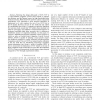802 search results - page 14 / 161 » Sink-to-sensors congestion control |
Publication
Delivering congestion signals is essential to the performance of networks. Current TCP/IP networks use packet losses to signal congestion. Packet losses not only reduces TCP perfor...
IPPS
2007
IEEE
14 years 1 months ago
2007
IEEE
Many modern massively distributed systems deploy thousands of nodes to cooperate on a computation task. Network congestions occur in these systems. Most applications rely on conge...
SIGCOMM
2004
ACM
14 years 25 days ago
2004
ACM
Recent research efforts to design better Internet transport protocols combined with scalable Active Queue Management (AQM) have led to significant advances in congestion control...
INFOCOM
2002
IEEE
14 years 10 days ago
2002
IEEE
– Typically, NACK-based congestion control is dismissed as being not viable due to the common notion that “open-loop” congestion control is simply “difficult.” Emerging r...
ICC
2009
IEEE
14 years 2 months ago
2009
IEEE
—Following the design philosophy of XCP, VCP is a router-assisted congestion protocol that intends to balance the efficiency and the fairness control in high Bandwidth-Delay Pro...

